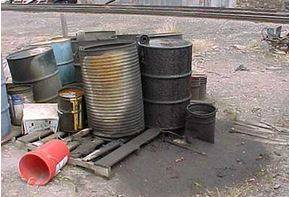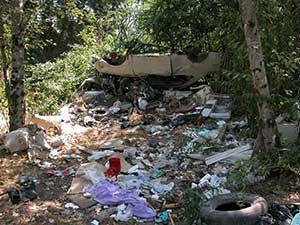Solid and Hazardous Waste
For additional information about solid and hazardous waste in Larimer County visit Larimer County Landfill Household Hazardous Waste

When the LCDHE receives a complaint regarding solid waste or hazardous materials, we either investigate based on the information provided, or refer the complaint to the appropriate code compliance or municipal entity.
Services provided:
- Perform routine inspections of licensed landfills and transfer stations
- Investigate allegations of illegal dumping activities
- Assist property owners and businesses in properly remediating contaminated sites
- Educate the general public on the proper handling, storage, transportation, and disposal of solid or hazardous waste according to applicable rules and regulations
- Provide consultation at hazardous and non-hazardous material spills that may pose a threat to health or the environment
- Provide information on potential environmental impacts of hazardous material spills including underground tank failures and accidental releases from vehicles
 Methamphetamine
Methamphetamine

LCDHE is not a responding agency for potential clandestine drug labs. All methamphetamine-related complaints or concerns should be first addressed with local law enforcement.
LCDHE assists local and state law enforcement in addressing methamphetamine contaminated properties and the remediation required for occupancy.
FAQs
-
Methamphetamine, often known as 'meth,' is a very strong and addictive illegal drug that boosts the brain's pleasure center. People use meth by smoking, swallowing, snorting, or injecting it. Even though using meth is against the law, many people still use it in the United States, including Colorado
-
Methamphetamine is often made or "cooked" in very basic, secret home 'labs' by people without chemistry knowledge or background. Meth is also produced in large amounts outside the US and brought into the country illegally.
-
Yes. The chemicals used to make methamphetamine are very hazardous and toxic. Breathing in, swallowing, or touching these chemicals can cause poisoning, sickness, or even death. Some of these chemicals used to make meth can also catch fire or explode if they're mixed or stored the wrong way.
-
Per the Colorado Regulations, a surface is considered contaminated when a certified sample returns a result measuring 0.5 ug/100cm2 or higher.
-
No. If you simply suspect that methamphetamine has been used in your facility, the regulation does not require you to perform testing.
-
The regulation requires that you test for methamphetamine when one or more of the following three situations exist:
- Results collected by a certified consultant are positive,
- Formal law enforcement activity involving meth occurs at the property,
- Documented evidence is provided confirming meth has been used, stored, processed, or manufactured within the property.
-
Per the Colorado regulations, any surface known to be contaminated with meth must be properly decontaminated by a certified contractor. The contractor will perform decontamination and then conduct “clearance” testing. A certified sample with a result of less than 0.5 ug/100cm2 indicates a surface is no longer considered contaminated.
-
No. Special training and personal protective equipment are required to perform decontamination, and surfaces known to be affected by meth must be decontaminated by Colorado-certified decontamination experts.
-
Breathing air or touching surfaces contaminated with methamphetamine residue is considered a secondary exposure.
The risks of secondary exposure to meth have not been well studied and there is limited information available. However, in large public or commercial buildings, the health risk of secondary exposure to meth is considered low. In these settings, the risk is considered low because the safety limit for contamination is very conservative and exposure times are likely to be short.
Contact Health
The Health Department has three locations:
Fort Collins office
1525 Blue Spruce Drive
Fort Collins, CO 80524
Loveland office
200 Peridot Avenue
Loveland, CO 80537
Estes Park office
1601 Brodie Avenue
Estes Park, CO 80517
To reach us at any of our locations please call: (970) 498-6700
Fax: (970) 498-6772


